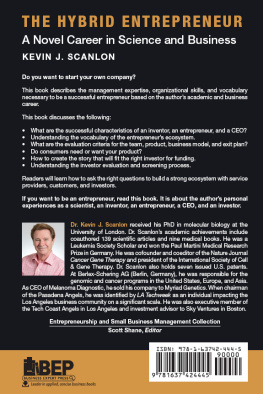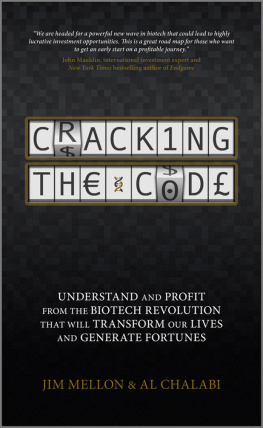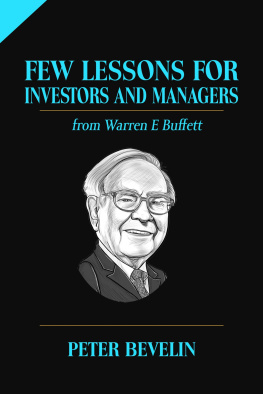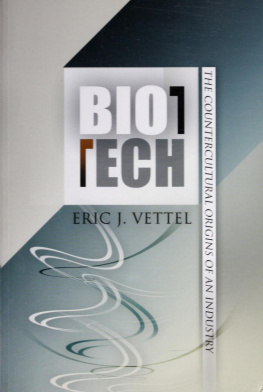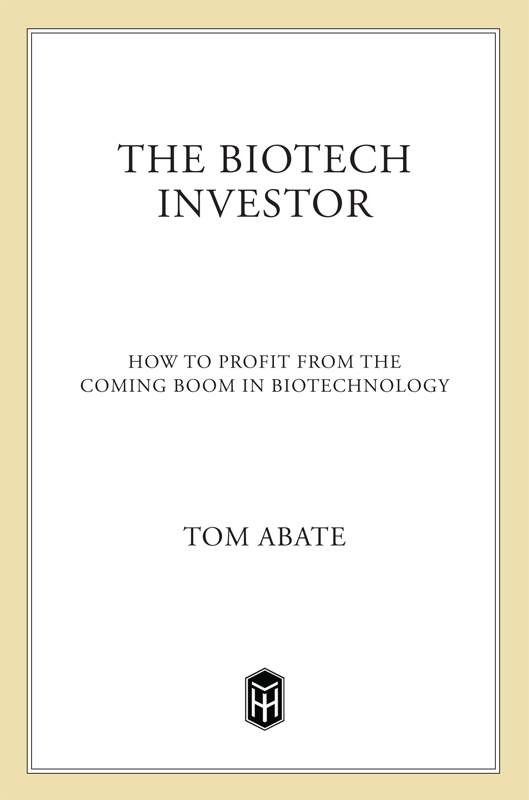
The author and publisher have provided this e-book to you for your personal use only. You may not make this e-book publicly available in any way. Copyright infringement is against the law. If you believe the copy of this e-book you are reading infringes on the authors copyright, please notify the publisher at: us.macmillanusa.com/piracy.
Contents
Preface: The Biotech Wave
In sitting down to write this book, several times I neared the point of despair. How could I ever hope to see far enough into the future to craft a biotechnology investment book that would still be useful two, three, even five years hence? After all, biotechnology is a cutting-edge field. Even its practitioners cannot guess how quickly scientific theories will develop into marketable productsif they ever succeed. And then theres the stock market, the poster child of unpredictability. Stock picking, says Lissa Morgenthaler, one of many professional investors who advised me in this project, isnt just figuring out which are the best biotech firms. Its about figuring out what the herd thinks are the best companies.
During one of many such doubt attacks, I took a break from writing to indulge my favorite hobby, gardening. I was down on my knees, rearranging paving stones on a bed of sand, when it struck me that my task was very much like writing this book. I was trying to build something on a foundation of sand. Every time I tapped a brick here to level the walkway, other bricks jumped up and out of place. The entire bed of sand kept slipping and sloshing beneath me in slow motion.
Still, I persevered, and the reward came before Id finished my walkway. The very thing that appeared to be my problem, this notion of shifting sands, really offered the metaphor to put this book into perspective. We all know that markets are cyclical, that they follow a wave pattern up and down. But biotechnologys wave is not a quick, wet slap of water on the shore. The biotech wave moves at the speed of sand, a speed consistent with the nature of the industry. Biotechnology is an experimental field. Only a handful of biotech companies currently have products on the market. The vast majority of biotech firms run at a loss during long development cycles aimed at proving their founding thesis. Experiments take time, and they often fail. Even when experiments have been done, and their results analyzed and presented at scientific meetings, biotech medicines undergo an excruciating process of regulatory review that can lead to approval, rejection, or demands for more testing. People used to joke about Internet time, the notion that everything in high tech moves at an accelerated pace. Biotech investing is governed by the opposite notion. In biotech time, development horizons stretch for years, even decades.
But like a sand dune, this slow-moving biotech wave can suddenly and treacherously collapse, crushing its followers. Anyone whos ever built a sand castle knows what I mean. You scoop a little sand away from the base, and nothing happens. Take another scrape, and still the edifice stands. Then you touch the wrong grain, and the whole structure tumbles down. Sudden, unpredictable collapses in stock price are the bane of biotech investors. A stock will be building in value, growing slowly over time. And youre patient. You arent worried. Youve learned to buy and hold. Then a report crosses the wire. A clinical trial failed to meet its primary endpoint. A government panel says it needs more safety data to make up its mind. Before you can react, that nice share price that took so long to build up has dropped 30 or 50 percent. As biotech hedge fund manager Kurt von Emster explains, its not that investors arent clever enough to choose a portfolio that includes several winners. The problem is that the slow gains of these winning stocks can be completely wiped out by an unforeseen setback on a single pick. What kills you in this business are the bombs, von Emster says.
Yet once you understand that youre dealing with a slow-moving sand wave, you can begin to detect the patterns of a stock thats near its trough, and another thats cresting so strong that any bit of bad news could send it toppling. The professional investors and money managers whom I interviewed in writing this book have learned to surf this slow-motion wave. Theyve learned how to profit from the movement of the wave itself. I dont simply mean the slow accumulation of grains over time, which is the classic buy and hold strategy. Many savvy investors realize they must play the ebbs and flows of the wave itself, accumulating stocks when they think they detect a trough, and cutting back their positions and harvesting profit when they fear the wave could topple. If this sounds like a trading strategy, it is. One of the important lessons in this book is that you will have to learn to sell the very stocks you lovebecause your analysis of the wave suggests that youll be able to buy them back cheaper at a later date.
Obviously, I cant look out ahead and see where the wave will be on a given day, which stocks will be ascending or toppling. But with the help of the many experts whove shared their experiences with me, along with my own years as a financial reporter covering the biotech industry, I can paint a landscape that will look very much like the scenes youll encounter as you build your portfolio. Ill show you where to stand to get the best view of a wave, and how to detect the signals that have, in the past, pushed it one way or another. I will also give you an overview of the many specialized niches within biotechnology. The creation of novel medicines is the main thrust of the industry and the predominant focus of this book. But biotechnology is also being used to modify crops and breed animals with desired traits. Biotech tools are being applied toward the development of new industrial enzymes. One day we may walk down the aisles of grocery stores and see detergents with the words BIOTECH POWERED emblazoned on their labels. Biotechnology is an industry with an ambitious agenda. It aims to understand and change living things, whether this means reprogramming bacteria to produce protein medicines, or genetically altering goats so their milk produces a protein that can be spun into fibers as supple as silk yet as strong as steel.
Each chapter in this book will cover a different niche or investment area. The first part of each chapter will generally be devoted to scientific and business developments affecting that niche. The last section of each chapter will have a different purpose: it will focus on investing tips or strategiesfor instance, how to chart the ebb and flow of stock prices around key scientific meetings. These end-of-chapter tips wont apply just to that niche. Theyll be general tools to help you invest in the coming biotech booms. At the end of the book Ill review the tools in one place, and make some suggestions aimed at different types of investors based on age, risk tolerance, knowledge of the underlying science, and familiarity with stock trading.
At that point, as you begin to investigate investments, youll have to add something no book or author can possibly supplyyour own focus and motivation. Of course, you want to make money. But if thats your only goal, there are easier ways. Biotechnology isnt rocket science; in fact, biotechnology makes rocket science look easy. Achieving your goals as a biotech investor will demand extraordinary study and research. I can show you how to sort the stocks and pick out the most promising disease areas and technologies. But youll have to do the hard work and make the tough decisions. The motivation for that sort of roll-up-the-sleeves investing will probably spring from something deeper than a simple desire to cash in on a hot industry. Perhaps your motivation will come from some special medical knowledge, or from a fascination with biology left over from courses youve taken in school. Or perhaps youve beaten a disease or know someone who has, and youve become curious about the industry that seems bent on tackling the root causes of illnesses. Dennis Purcell, a leading biotech analyst and money manager, switched over from high tech and began following biotech stocks after he was treated for a tumor.


